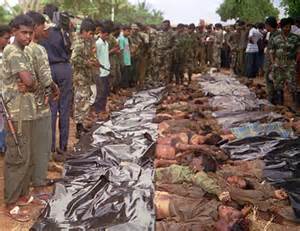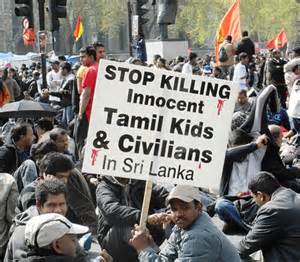Sri Lanka Conflict

A twenty-five year civil war in Sri Lanka came to a close in May 2009. The war was an insurgency against the Sri Lankan government by the Liberation Tigers of Tamil Eelam (LTTE, or Tamil Tigers), a separatist militant organization.
Although the fighting has ceased, more than 70,000 people have died and hundreds of thousands are left internally displaced. Thousands of civilians have fled the country. The economy has suffered from the dual impact of the civil war and the subsequent cut in aid from foreign donors in their efforts to pressure the Sri Lankan government to address the humanitarian crisis. The government and LTTE both have been accused of human rights violations including abduction, conscription and use of child soldiers, indiscriminate shelling of civilian villages, the use of human shields, torture, and gender-based violence.
With the end of the war, the government of Sri Lanka called for redevelopment of the nation. The final stages of the war left at least 300,000 people displaced. By May 2010, nearly 215,000 Internally Displaced Persons had returned to their places of origin.
The Democratic Socialist Republic of Sri Lanka is an island in the Indian Ocean, located south-east of India. The capital, Colombo, is located on the west coast of the country.
In 1956, the Official Language Act was enacted. This law mandated Sinhala as the sole official language of Sri Lanka. This is the language of Sri Lanka’s majority Sinhalese community and is spoken by over 70% of Sri Lanka’s population. This was intended to act both as a statement of independence from Britain and as a clear sign of superiority of the Sinhalese over the Tamil. Consequently, this act forced large numbers of Tamil who worked in the civil service, and who could not meet this language requirement, to resign. Affirmative action in favor of Sinhalese was also instituted at the same time. Many Tamil interpreted this deliberate marginalization as proof that they deserved a separate nation-state for themselves.
Ethnic tension exploded in July 1983, expanding Tamil liberation groups and propelling the country into a war between those groups and the Sri Lankan government. On July 23, 1983, thirteen Sri Lankan soldiers were killed when they drove over a landmine in northern Sri Lanka, sparking riots for the next four days throughout the country. Sinhalese crowds burned and destroyed Tamil property and attacked Tamils. The government was slow to respond to end the violence. In some instances, it was reported the state helped Sinhalese rioters by transporting them in governmental vehicles and giving them information so they could more easily find Tamil targets. By July 28, there was an estimated $300 million in property damage, 70 percent of the Tamils in Colombo were refugees, and between 2,000 and 3,000 Tamils were dead.
By the late 1990s, the LTTE (the rebels) occupied 70 percent of northern and eastern Tamil areas. Yet by spring 2009, the LTTE was near defeat. The fighting had shrunk to a three-square-mile of LTTE-controlled land. The heightening intensity of the fighting, however, came at a high cost to civilians. The United Nations reported in April that 115,000 people had been able to escape that war zone, but 50,000 people remained trapped.
In May 2009, Government forces re-conquered all rebel-held territory. On May 19, 2009, the government formally declared an end to the decades-long civil war after the LTTE leader was killed. There are competing accounts of the death, whether he was killed directly by the government or died in battle.
Two decades of fighting left hundreds of thousands of Tamils to flee to camps for the internally-displaced. There, Tamils faced inadequate access to health care, education, and appropriate nutrition. The Sinhalese government militarized these civilian camps, failed to allow freedom of movement, limited the access of reporters and aid workers, and expelled many humanitarian aid agencies. Gender-based violence became epidemic, and a further danger exists in the continued threat posed by land mines. In response to the Sinhalese government’s failure to improve conditions for the Tamils, a number of countries cut off or limited their aid funding.
During the 1970s, India trained and armed the LTTE. India has a significant population of Tamils, and this population generated considerable support for the LTTE movement. During the 1980s, the LTTE began creating alliances with separatist groups in India. India soon withdrew its support. In 1987, India pledged the Sri Lankan government to send peacekeeping troops to the island. The Indian forces were unable to end the conflict and began fighting with the LTTE. India withdrew its troops in 1990. Although India has been wary of getting involved in Sri Lanka, economic trade between the two nations has greatly increased. Many in India, including the Indian Tamils, continue to express concern about the conditions of the Tamil minority in Sri Lanka.
The United States was never a major player in the Sri Lankan civil war. The United States suspended military aid to the country in December 2007 due to Sri Lanka’s human rights violations. The United States government also labeled the LTTE to be a terrorist organization.

